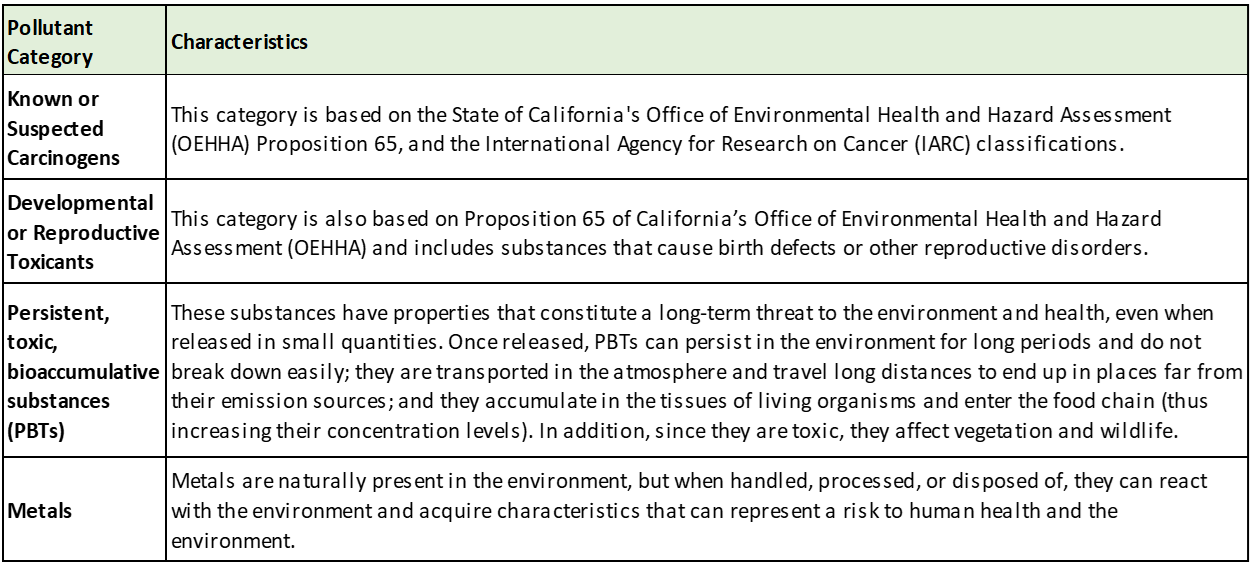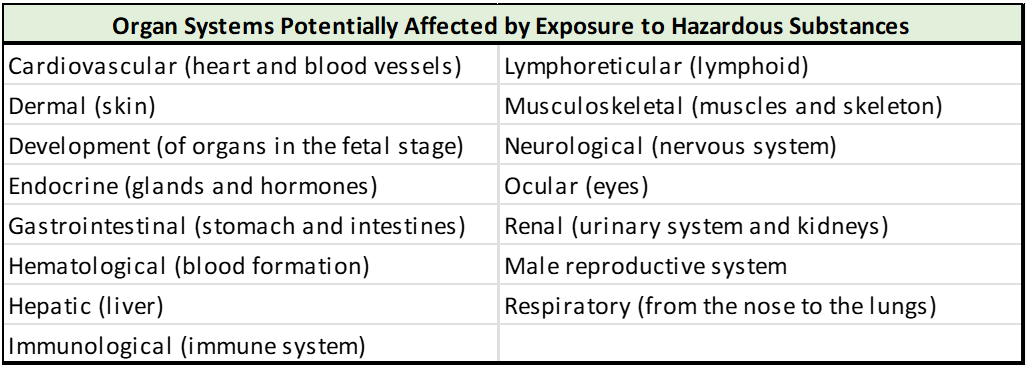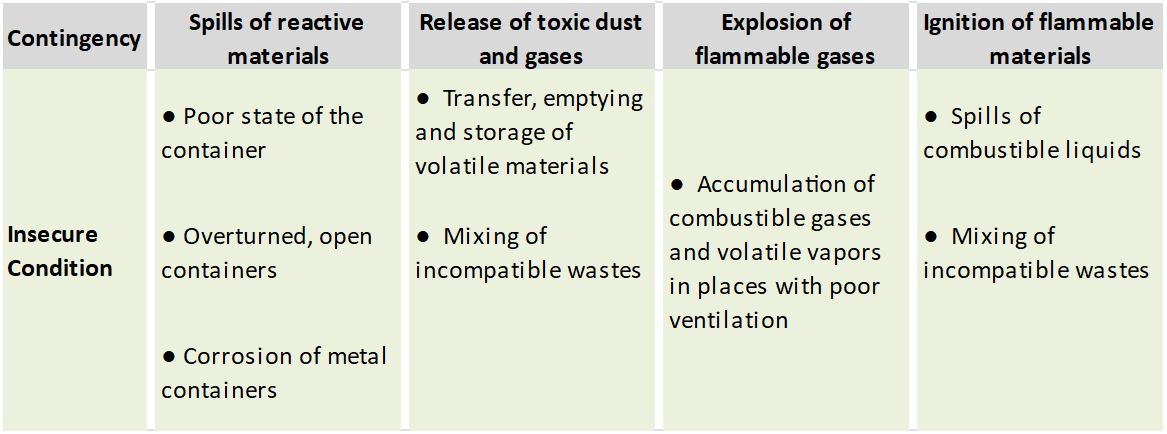2 Feature Analysis: Off-site Transfers to Disposal in North America, 2014–2018
2.3 Waste Disposal Practices and Their Potential Impacts
2.3.2 Environmental and human health concerns related to industrial waste disposal
Industrial waste is defined as waste generated in an industrial facility that, due to its volume and characteristics, may represent a risk to the environment and human health and cannot be managed by municipal waste collection services. As such, industrial waste is regulated under a different legal framework than domestic waste. For the purposes of this report, industrial waste is defined as the substances manufactured, processed, or used in industrial or production processes and resulting in residual pollutants that must be managed in an appropriate manner to avoid risks to the environment and public health.
There exists a wide variety of industrial waste types, which can take the form of solids, liquids, sludges, or gases. Some waste can be hazardous (i.e., toxic, inflammable, corrosive, explosive, oxidizing, radioactive, etc.)[21] Under the EPA hazardous waste is also classified as listed waste—i.e., waste included in one of the F, K, P, or U lists published in the Code of Federal Regulations (40 CFR, Part 261).[22] Examples include waste from spent solvents, electroplating, wood preservation, production of chemicals and pesticides, oil refining, etc.
Table 7 provides examples of the types of hazardous waste generated by industrial processes. Each of these types of waste may contain multiple chemicals, including ones found in the above-mentioned lists. For example, acetone, methanol, petroleum distillates, pigments, toluene, and other substances may be used in furniture dyeing and painting processes (EPA 2021h).
Table 7. Examples of the Types of Hazardous Waste Generated by Industrial Sectors
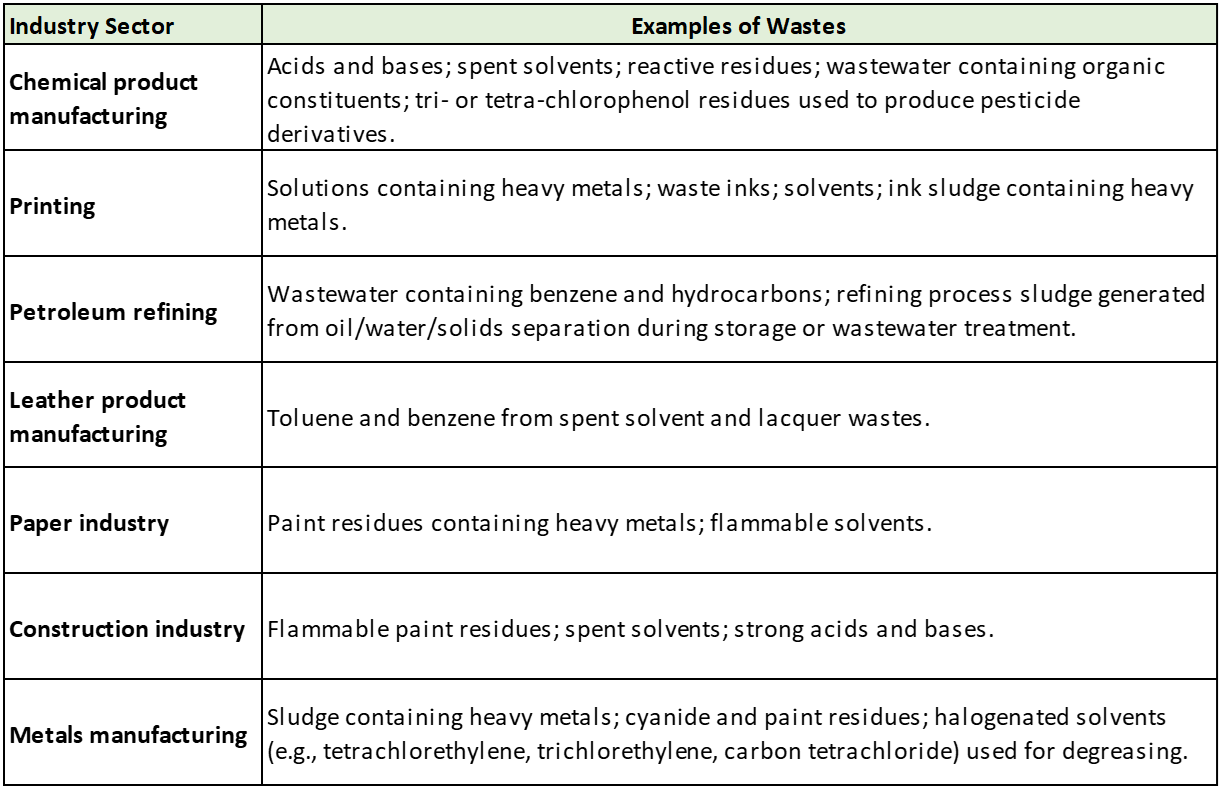
Adapted from: EPA, 1986: Solving the Hazardous Waste Problem: EPA’s RCRA Program; and CRF Title 40, Part 261, Sub-Part D.
It is important to remember that other types of waste, which, although not officially defined as hazardous, may be harmful in some way. For example, the nitrates contained in agricultural runoff or wastewater treatment sludges can deplete oxygen in receiving water bodies and cause eutrophication, which impacts fish populations and aquatic plants.
Risk from exposure to hazardous substances
The wide range of substances recognized as potentially harmful suggests that much of the waste generated by industrial activities in North America may be considered hazardous in one form or another. In fact, most of the substances considered hazardous in one country are also considered hazardous in other countries.[23] Waste that contains PRTR listed substances is of interest regionally and globally due to their intrinsic characteristics in terms of toxicity, bioaccumulation, and persistence. This is the case for lead, mercury, cadmium, arsenic, and chromium, as well as for substances classified as persistent organic pollutants (POPs). In light of such factors there is a need to control the use and production of these substances, as well as their environmentally appropriate management or disposal.
In Canada, Mexico, and the United States, PRTR substances are subject to the reporting requirements specific to each program. Some of these substances, due to their characteristics of volatility and solubility, or to phenomena such as leaching, tend to migrate to other locations, which can make it difficult to control them. Hence the need for cooperation between agencies or countries to identify potentially contaminated sites and/or populations exposed to PRTR substances.
In Taking Stock Online, PRTR substances are broken down into four categories, according to their risk for human health and/or the environment (Table 8):
Table 8. Classification of PRTR Substances according to Their Potential Risks to Human Health or the Environment
The characteristics and risks listed in this table can be present individually, or in aggregate, in each substance. As mentioned in chapter 1 (Figure 8), to determine the risk a substance represents for an organism, system, or target (sub-)population one must have information regarding various factors, such as the substance’s toxicity, the type and route of exposure, and so on. Assessments of chemical risks to human health may be done by analyzing past, present and even future exposures to any chemical product found in the air, soil, water, food, consumer products, or other materials and may be quantitative or qualitative (WHO 2017). These risk assessments may also help to determine the risk of exposure at storage, treatment, or waste confinement facilities. Environmental assessment consists of comparing a substance’s concentration in the environment and the level of concentration at which an environmental effect occurs, taking into consideration the routes of exposure, levels of organization (of organisms, populations, communities, ecosystems) and species of flora and fauna present in the environment.
The EPA’s Report on the Environment (ROE) assesses nine human disease indicators (asthma, birth defects, cancer, cardiovascular diseases, childhood cancer, chronic obstructive pulmonary disease, infectious diseases, low birth weight and premature births) for which exposure to environmental pollutants may be a risk factor (EPA 2020b). Birth defects, which are defined as structural or functional anomalies that appear at birth or in early childhood and result in physical or cognitive disabilities, is one of the indicators related to environmental exposure to high levels of pollutants, such as polychlorinated biphenyls (PCBs) or mercury (EPA 2020a). Similarly, pollutants such as lead are a risk factor for premature births (EPA 2019b). Exposure to radon and arsenic is associated with lung cancer and skin cancer, respectively (EPA 2020a).
The Agency for Toxic Substances and Disease Registry (ATSDR) provides information on the harmful health effects of exposure to hazardous substances. Table 9 presents information on the organ systems affected by exposure to hazardous substances, according to the ATSDR. It should be noted that in most cases the risk factors for developing these illnesses are multifactorial and the development of a particular disease depends on the magnitude, duration, and timing of the exposure. These conditions may be associated with, but often cannot be directly linked to, pollutant levels or other environmental parameters. The opportunity and challenge that environmental and public health authorities confront relate to obtaining information on exposure to hazardous substances to analyze the risks they pose and the connections with environmental or health impacts.
Potential environmental and health effects associated with industrial waste disposal
PRTRs have become an international tool for industrial facilities to report the releases and transfers associated with their activities. PRTR substances reported in off-site transfers to disposal usually correspond to volumes of waste managed under controlled conditions and subject to regulatory requirements that specify the technical safety conditions that govern their management. Conversely, inadequate waste management at any stage, including storage, transfer, or treatment, can result in leaks or spills, which can, in turn, lead to hazardous substances being transported by or deposited in surface or groundwater flows, or to their volatilization in the atmosphere or retention in living organisms. Although waste disposal activities must adhere to best practices to ensure the safety of waste management personnel and to prevent harmful substances from coming into contact with living organisms or the environment, there will be times when unsafe conditions, inside and outside facilities, cause waste spills or chemical reactions that lead to the contingencies described in Table 10.
Table 10. Contingencies Related to the Poor Management of Industrial Waste
Similarly, during the various stages of waste management, such as treatment or final disposal, some fraction of the waste materials may be released into the environment. For example, in the case of hazardous waste incineration, it is necessary to transport ashes to disposal as they may contain trace quantities of hazardous substances. This process may require off-site transfer to a confinement site where conditions must ensure that these ashes remain in confined disposal cells to prevent their contact with any living organism or any release into the environment. With other pyrolytic processes, such as co-processing, thermal waste recovery or biomass energy generation, emissions of harmful substances such as dioxins and furans may be generated in the absence of advanced control systems. Consequently, landfills and controlled confinement systems must be equipped with systems and controls to avoid open air waste burning and the generation of black carbon and methane gas emissions, which are potent vectors of global warming.
Another example is sewage sludge, which, once it has been treated, can be used for land application, or as agricultural fertilizer or manure in public sites such as parks. However, if these materials exceed the prescribed permissible limits for pollutants (for example, heavy metals), they may generate risks for human health and ecosystems.
The transport of pollutants in the environment requires the movement of gases, liquids and particulates through water, soil, or air, in combination with climatological, geomorphological or geohydrological factors. In the case of pollutant transport by means of a liquid, a mechanism such as surface runoff, filtration through soils, or displacement in porous media is required to facilitate this process (Sánchez 2003, p.70). Figure 10 presents some of the mechanisms that enable the transport of pollutants in the environment and influence their dissolution and destination, thereby increasing or reducing the risk they pose.
In addition to their negative effects on the environment, pollutants generate other phenomena which can put biota at risk. One example is biomagnification, which occurs when certain substances, such as pesticides or heavy metals, are dispersed in rivers or lakes where they enter the food chain through ingestion by aquatic organisms like fish, which in turn are eaten by large birds, animals, or human beings—thus accumulating in the food chain and leading to concentrations in tissues or internal organs (EPA 2016b). Figure 11 illustrates, in a general way, examples of some of the environmental impacts caused by the dispersion of pollutants.
Figure 11. Potential Impacts Caused by the Movement of Pollutants
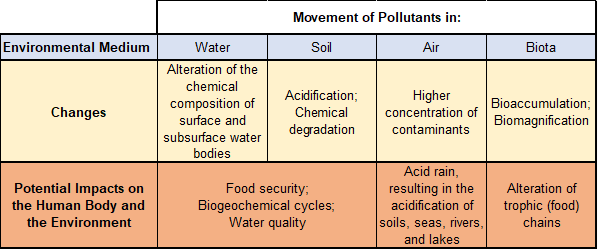
Concerns exist regarding the environmental and health effects associated with the PRTR substances transferred to disposal in North America. Civil society organizations in the three countries have expressed their concern regarding contaminated sites, particularly in relation to pesticide residues and heavy metals like lead and mercury, as well as exposure to unintentional pollutants such as dioxins and furans. “Legacy” pollution, in sites such as Love Canal,[24] is the result of hazardous waste being abandoned and left in the open, or because of inadequate management of waste confinement sites by industrial facilities or mining operations.
The following are examples of specific concerns related to certain disposal practices.
Disposal by underground injection
Although underground injection can constitute an effective waste management practice, it raises concerns due to the possibility of pollutant dispersion. There exist two possible vectors of contamination that may facilitate the migration of injected fluids to aquifers:
- A failure in the injection well, due to leaks in the injection piping or pipe insulation; or from a loss of internal mechanical integrity, which may be caused by corrosion (which, in turn, may be due to the properties of the injected waste); or from a mechanical failure in the piping materials; and
- The incorrect location of other wells, which can result in their penetration into the injection well’s confinement area. This can be a common occurrence in oil and gas exploration zones.
Key factors to consider are the amount of waste injected and the proximity between wells, to avoid generating a pressure of such magnitude that the waste moves from one well to another, causing leaks of harmful substances. Also, the injection of incompatible wastes could cause them to react and damage the infrastructure of the site (EPA 2001; Ferguson 2014).[25]
Oil industry waste disposal wells in West Virginia, United States
In 2016, the Natural Resources Defense Council (NRDC) conducted an analysis of class II disposal wells in West Virginia, United States, which revealed a series of ongoing problems with respect to compliance with environmental regulations. Class II wells are used by the oil and gas industry to improve oil recovery in deep formations or to dispose of wastewater generated by exploration and production activities. Among the problems encountered were ongoing injection operations with expired permits; failure to conduct mechanical integrity testing as often as required; and over half of non-operational wells not capped in accordance with regulatory requirements, in some cases even after ten years.[26]
That same year, the EPA compiled information based on various characterization studies of wastewater generated by oil and gas operations. Among the components detected in the wastewater were total dissolved solids, total suspended solids, chloride, oil and grease, benzene, toluene, ethylbenzene, xylene, heavy metals such as barium, strontium and magnesium, and radioactive materials. Among the six principal routes identified by the EPA for the migration of these wastewater components into potable water sources were well casing pipe failures and migration from improperly capped abandoned wells.
Confinement in landfills or surface impoundments
The confinement of hazardous substances in landfills or surface impoundments raises concerns due to the potential pathways for the release of pollutants, which include:
- releases of gas or vapors to the atmosphere
- winds, which may lift and suspend fine particulates in the air,
- migration of substances via the soil, groundwater, or surface water, and
- direct exposure of persons or wildlife to hazardous materials via a breach in the site’s containment system (CCME 2006).
Therefore, having information about the types and amounts of the substances contained in a landfill or surface impoundment can help manage the impacts of such releases.
Coal ash ponds in the United States
Coal combustion residuals (CCRs), or coal ash, are byproducts of the combustion of coal by electric utilities. Coal ash contains contaminants like mercury, cadmium and arsenic associated with cancer and various other serious health effects. In 2012, approximately 110 million tons of coal ash were generated, 40% of which was beneficially used (e.g., in cement), with the remaining 60% disposed in surface impoundments and landfills (commonly known as coal ash ponds) averaging 120 acres and 40 feet in depth.[27]
In 2019, an environmental nongovernmental organization (NGO) collaborated in the compilation and analysis of the groundwater monitoring data published by over 200 coal-fired power plants or off-site coal ash disposal sites in compliance with the EPA’s 2015 Coal Ash Disposal Rule, which established groundwater monitoring requirements for coal ash landfills and required electric utilities to make the data public as of 2018. The data cover over 550 different coal ash ponds and landfills that are monitored by over 4,000 groundwater monitoring wells, representing around 75% of the country’s coal-fired power stations.
A comparison between these groundwater monitoring data and the health-based standards and government advisories revealed the existence of contaminated water beneath most of the plants in the study. Over 50% of the sites had dangerous levels of arsenic and lithium, which are known for their potential to cause neurological damage, and ten sites had concentrations of these and other pollutants (for example, cadmium, cobalt, selenium, molybdenum), that were 100 to 500 times the recognized safe levels.[28] One of these sites, the Big Sandy Power Plant in Kentucky, was included in the EPA’s list of high hazard potential ratings because the groundwater on its site contains dangerous levels of arsenic, radium, cobalt, sulfates, beryllium and lithium.[29]
In January 2022, EPA announced it will enforce the 2015 Coal Ash Disposal Rule to address the more than 500 unlined coal-ash ponds in the United States.[30]
Tailings management areas in Alberta, Canada
Canadian oil and gas extraction facilities, as well as other mining facilities, may dispose of their tailings in tailings management areas, either on- or off-site. In 2017, two NGOs and a Canadian citizen filed the Alberta Tailings Ponds (II) complaint via the CEC’s Submissions on Enforcement Matters mechanism. The submitters affirmed that the Government of Canada was failing to enforce the pollution prevention provisions of the Fisheries Act, in relation to the alleged release of deleterious substances in surface waters frequented by fish or via the groundwater and soil surrounding these waters in northeastern Alberta.
The pollutant substances are contained in oil sands process-affected water (OSPW), a by-product of the tailings generated by mining operations. OSPW contains a toxic mix of naphthenic acids, heavy metals and other chemicals, the result of the process of separating oil sands from other materials during open-pit mining operations. Tailings ponds are designed for the temporary storage of OSPW and enable the tamping down of the fine particulates in the tailings (by submerging them under water). However, due to the challenges of maintaining the structural integrity of the walls of tailings ponds, OSPW slowly filters through these containment structures.
In its response to the submission, the Canadian government acknowledged that no applicable federal regulations exist regarding the depositing of substances in oil sands tailings ponds. However, regulations on oil sands effluents are currently being drafted under the Fisheries Act to prohibit the depositing of OSPW, including OSPW from tailings ponds, in waters frequented by fish or any other place where OSPW might enter such waters.[31]
Breach of a mine tailings dam in Sonora, Mexico
A spill at Grupo Mexico’s Buenavista del Cobre mine in Sonora, Mexico, in 2014 was caused by a broken pipe in an acid copper tailings pond. An estimated 40,000 m3 of a metal-laden, highly acidic solution was released into the Las Tinajas stream, which flows into the Bacanuchi River and then the Sonora River. The spill’s initial impacts extended 90 km downstream, raising concerns about effects on aquatic life, drinking water and the economies of seven communities (Gobierno de México 2014, Díaz-Caravantes et al. 2016, Jamasmie 2014, Gutiérrez Ruiz and Martín Romero 2015).
Land application
The application of treated biosolids to land is considered an alternative for soil that has been degraded due to intensive agricultural use, or for use in forests or other lands. However, various stakeholders, including governments, have expressed their concern regarding the sound control and treatment of the pollutants.
Inadequate monitoring of substances contained in biosolids in the United States
A November 2018 report of the EPA’s Office of the Inspector General identified deficiencies in the agency’s controls on the use of biosolids in land application in relation to the protection of human health and the environment. While the EPA constantly monitored biosolids to detect the presence of nine regulated pollutants (heavy metals), it lacked the necessary personnel, data, and risk assessment tools to evaluate the safety of 352 pollutants found in biosolids (including pharmaceutical chemicals, steroids, and flame retardants), identified in studies conducted between 1989 and 2015. Sixty-one (61) of these pollutants are designated as highly hazardous, hazardous or priority substances by other programs. Under the Clean Water Act, the EPA is required to review its regulations on biosolids at least once every two years to identify additional toxic pollutants and, as required, develop related regulations (EPA 2018a).
Lack of treatment of sludges prior to disposal in Mexico
Mexican authorities have recognized that, at times, guidelines for the design and application of sludges are not respected and that these materials are applied to agricultural soils without having received adequate treatment (Conagua 2015). Various studies have shown that wastewater treatment plants dispose of untreated sludges in open air locations, or on land which has not been prepared for this purpose (Ortiz et al., 1995; Cardoso et al. 2000). According to the findings of a 2016 audit of a treatment plant in Ensenada, Baja California, sludges were simply mixed with other materials and disposed of in situ, on the grounds of the plant (Ramírez et al. 2016).[32]
These examples reveal that there remain many opportunities for developing and strengthening environmental and safety standards relative to the disposal of hazardous substances. This is relevant not only at the national level, but also with respect to transboundary movements of hazardous waste for purposes of disposal.
Cross-border transfers of industrial waste in North America: Environmental, social, and economic considerations
One of the regional and global concerns associated with industrial waste management is the tracking of transboundary movements. Canada, Mexico, and the United States are signatories to the Basel Convention on the Control of Transboundary Movements of Hazardous Wastes and their Disposal. Under this Convention, transboundary transfers of waste must only be undertaken for waste treatment prior to disposal, or for processing to enable some form of waste recycling or recovery.[33]
The Taking Stock Online platform includes data on transboundary movements of substances reported to the three countries’ PRTR programs. Data for the 2014–2018 period show cross-border transfers in amounts of between 208 million kg and almost 270 million kg per year (Figure 9).[34] Most were pollutants transferred to recycling, with smaller proportions transferred to treatment or energy recovery. Pollutants transferred across borders for purposes of disposal mainly went to landfills or surface impoundments, as well as to facilities for their stabilization or treatment prior to disposal.
The selection of the technology or treatment for a given type of industrial waste depends on a number of factors, including the technical considerations relating to the characteristics and volumes of the waste generated; market-related economic factors; legal considerations, including relevant national, regional and international environmental regulations; and the local considerations, such as the proposed location of the facility, environmental and social risks, and impacts on long term land-use planning.
In general, waste treatment and disposal technologies or processes may be classified in descending order of cost, as follows:
- Incineration is the highest cost option. Costs vary depending on whether the substance is a liquid, sludge, or solid and on the concentration of pollutants.
- Confinement or landfill. Costs vary according to the physical state of the waste materials.
- Underground injection. Costs vary depending on well depth, soil type and the type of waste.
- Land application, the lowest cost option, is used for waste that can enhance soil productivity.
While facilities dedicated to waste storage, recycling, treatment, or disposal are a source of employment and bring benefits to the local economy and the communities in which they are located, they can also pose risks for health and ecosystems when poorly designed or operated. However, when waste management systems comply with the applicable regulations, these risks are significantly reduced. The sound management of industrial waste considered to be hazardous has always been a source of concern for authorities, for the communities where the generating industries and waste treatment or disposal sites are located, and for communities located along transport routes. There is a societal perception that because disposal sites are where hazardous waste is confined, they constitute a latent risk. Consequently, the public is usually opposed to the presence of these types of facilities in or near their communities.
In North America, hazardous waste is usually transported by road or by rail, which can involve passing through populated areas and the risk of negatively affecting the health of residents and/or ecosystems. The three countries have systems for the authorization and transport of hazardous waste, as well as for registering and tracking the materials to enable them to monitor the transport of waste from its point of origin to its destination. However, there is some uncertainty with respect to off-site disposal that involves the contracting of a third party, particularly when international borders are crossed (CEC 2011).
In 1965, the Mexican government created the Manufacturing Industry, Maquiladora and Export Services program (Industria Manufacturera, Maquiladora y de Servicios de Exportación—IMMEX), also known as the “Maquiladora Program,” to promote trade. The IMMEX program allows manufacturers to import equipment, materials, and assembly components tariff-free, provided their production is eventually re-exported. There are nearly 3,000 maquiladora companies currently operating in Mexico, approximately 90% of them in the border area. These companies—many of them assembly or processing plants—account for 55% of Mexico’s manufacturing exports and are engaged in trade with other countries, especially the United States. Many sectors make use of maquiladoras—for example, the automobile industry, aerospace, electronics, household appliances, garment-making, and jewelry, as well as call centers, logistical service and financial consulting companies, etc. (NTCD 2020).
A focus of the exchanges under the IMMEX program is the temporary importation of waste related to dismantling services for the reuse and recycling of parts (SE 2008). As mentioned earlier, approximately 98% of cross-border transfers are for recycling. The Mexican companies active in recycling products or waste containing PRTR substances are, by and large, maquiladoras—many of them employing female workers. It is important to consider the fact that women, and especially pregnant women (because of the possible health implications for prenatal development) are often more vulnerable to the health impacts of exposure to PRTR substances.
While they are considered distinct from hazardous waste and regulated separately, urban solid waste and special waste (e.g., from construction sites) can also present risks. An important policy consideration, especially for Mexico, is the introduction of formal employment conditions for informal sector waste collectors, who normally perform their work under very precarious conditions, for low incomes and with high health risks. Such a policy involves, for example, programs to train these workers and incorporate them into the formal employment sector, thereby providing opportunities to improve their social and economic conditions. Another issue which should be regarded as critical is promoting gender equity in waste management and especially, waste separation activities. Traditionally, women’s participation in this type of activity is neglected or minimized; however, it is increasingly common for women to engage in various jobs and occupations, including in this sector.
Under the 1983 La Paz Agreement, signed by the United States and Mexico to protect and improve the environment along their shared border, the two countries have undertaken a series of initiatives, the most recent being the Border 2025 Program. A key objective of this program is to strengthen the Binational Consultative Mechanism, originally created in 2000 as an instrument for sharing information on hazardous waste management facilities and plants engaged in recycling lead-acid batteries and used electronics in the border area. This mechanism was developed in recognition of public concern regarding waste storage, treatment, and disposal facilities (EPA and Semarnat 2021).[35]
Cross-border transfers of spent lead-acid batteries in North America
A CEC report from 2013, entitled Hazardous Trade? An Examination of US-generated Spent Lead-acid Battery Exports and Secondary Lead Recycling in Canada, Mexico, and the United States, was developed to address concerns about a surge in US exports of spent lead-acid batteries, primarily to Mexico, resulting from the strengthening of US ambient air and emissions standards for lead in 2008 and 2012, respectively. These increased exports resulted in a higher risk of exposure to lead by workers and the people living near certain recycling operations in Mexico. The report revealed that more than 50% of the secondary lead smelters in that country had not reported their lead emissions to the RETC, partly due to a lack of clarity about whether some of these smelters could be classified as recycling facilities and thus not be subject to RETC reporting requirements for air emissions. The report’s recommendations paved the way for the establishment of clear emission standards for secondary lead smelters, as well as the reporting of their lead emissions to Mexico’s RETC.[36]
These standards cover not only air emissions from active smelters, but also the risks of contamination arising from abandoned operations. One such facility is the former Metales y Derivados lead smelter and battery recycling maquiladora in Tijuana, Baja California –a subsidiary of a US company. As described in the CEC’s Submission on Enforcement Matters (SEM) factual record from 2002, this abandoned site constituted a hazard to the nearby community because it was contaminated with approximately 6,000 tons of lead slag, sulfuric acid, antimony, arsenic, and cadmium that could easily spread due to exposure to the wind and rain. The public scrutiny resulted in the site being remediated in 2008.[37]
[21] See: Government of Canada (2017), “Guide to Hazardous Waste and Hazardous Recyclable Material Classification: chapter 2”; EPA (2016), “Hazardous Waste Types: Characteristic Wastes”; INECC, “Manejo de materiales y residuos peligrosos”.
[22] CFR, “Subpart D: Lists of Hazardous Wastes”, Code of Federal Regulations, Title 40, Chapter I, Subchapter I, Part 261.
[23] See Canada’s CEPA Priority Substance Lists; Mexico’s various substance lists: “Sustancias químicas: datos y recursos”; and US’ ATSDR Substance Priority List (SPL) Resource Page. Also refer to: Canada’s “Export and Import of Hazardous Waste and Hazardous Recyclable Material Regulations – Guide to Hazardous Waste and Hazardous Recyclable Material Classification”, and Mexico’s National Chemicals Inventory update (2010-2013).
[24] Love Canal, located in Niagara Falls, New York, was dredged to supply industry with low-cost electricity. Between 1942 and 1953, the Hooker Electrochemical Co. disposed of over 21,000 tons of hazardous chemicals into the abandoned canal, thereby contaminating the soil and groundwater (as confirmed by studies conducted in the 1960s and 1970s). In 1983, the EPA included the site on the Superfund program’s National Priorities List. See “Love Canal: The Disaster that Inspired the Superfund”.
[25] See also Simpson and Lester (2009) report, with examples of underground injection issues in the US: Deep Well Injection an Explosive Issue.
[26] “West Virginia’s groundwater is not adequately protected from underground injection,” NRDC report, 2019.
[27] “How and where is coal ash currently generated and disposed?”, in EPA’s Frequent Questions about the 2015 Coal Ash Disposal Rule.
[28] EIP. 2019. Coal’s Poisonous Legacy: Groundwater Contaminated by Coal Ash Across the US, Environmental Integrity Project, March 4, 2019.
[29] “Big Sandy Plant”, from Environmental Integrity Project’s Ashtracker site.
[30] CNN, “EPA begins enforcement on clean up of toxic coal-ash ponds”, January 11, 2022.
[31] CEC 2020. Alberta Tailings Ponds II: Factual Record regarding Submission SEM-17-001.
[32] SSWM, “Aplicación de lodo”, data sheet, Sustainable Sanitation and Water Management Toolbox.
[33] While the three countries have signed the Convention, only Canada and Mexico have ratified it (ref: section 2.3.3).
[34] In general, the total volume of releases and transfers reported each year in Mexico is much lower than in Canada and the United States. As noted earlier, readers can consult the NPRI website to see recent revisions to Canadian cross-border transfers data for the 2014-2018 period.
[35] Border 2025: United States-Mexico Environmental Program, EPA and Semarnat, 2021.
[36] CEC 2013. Hazardous Trade? An Examination of US-generated Spent Lead-acid Battery Exports and Secondary Lead Recycling in Canada, Mexico, and the United States.
[37] CEC 2002. Metales y Derivados. Final Factual Record (SEM-98-007).
